Name at least 3 methods of Manchester Code or Bi-Phase,
a) Mark, Space, Transition
Name at least 3 sync levels in communication;
a) bit sync, b) word sync (~byte) c) frame sync
What is optimal for frame sync?
Cross-Correlation code where code words have high uniqueness when in sync vs out of sync. i.e. Pattern detection scheme that is also least likely to be data too.
This is essential when converting serial bits to parallel words and frame sync.
This is what I knew 35 yrs ago when I first implemented a SCADA system in mid-70's. It may have changed now. Clock sync can be as simple as an XOR with a 1 shot delay on transitions to create a non-retriggerable clock, or better a PLL with transitions sampling an ultra stable VCXO using a Sawtooth clock signal and data edges to sample the phase error Voltage.. Of course your Bandpass filter and medium will introduce jitter, so you must learn to use Raised Cosine Filters where bit shift is zero. The bit error rate or BER is a function of the asymmetry of your clock slicer, jitter & phase error in your clock and jitter in your data. BER is directlly predictable from SNR and Phase margin tests help isolate the cause of your BER issues by using reduced and shifted timing windows to force your clock off center and see if data is still valid.
This is the secret method to analyzing any marginal communication system. I applied to my SCADA comm, Telemtry to aerospace, HDD data recovery and Telecom T1 days.
( if you want details on sawtooth VCO with Sample & Hold phase error from data transitions.. just ask :p) more than 30 yrs ago I designed but I think I can still do it.
Of course that was a synchronous comm channel.. You can use it for ASYNC comm too. and perhaps is what you intended with the preamble bits. . I used +/- peak and hold detectors for the slicer tracking filter.
If none of these answers work for you, maybe try another question....
